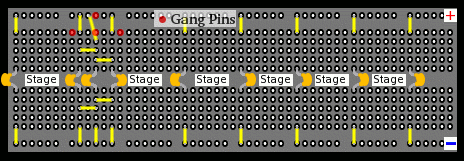Construction tips
Due
to the fact that the standing wave
length is much shorter in the VHF frequency range, you must know
certain construction tips to be able to make this radio function
correctly or you will have a fancy oscillator.
I am showing you this on a
prototype
board but care must also be exercised on a etched board; although the
prototype board is a heavy RFI contributor if not used properly; the
board is just easier to draw, and it allows you to be able to
experiment with the radio.
Many people
don't know this but
etched
boards are etched in a certain way so that there traces act as
shields, understanding this is the best way you can make a good super
heterodyne.

Never
use a prototype board with a metal bottom, and put screws and
nuts through the holes on the bottom to act as standoffs to hold the
board about 1/2 inch from the surface it is sitting on.

After
you build each stage jumper off (with
the shortest wires possible)
and capacitor the area around it; this will ensure that no stray RF
is coming in or out and act like a shield; the capacitors are 0.01uf
(on the AM one use
0.1uf caps).
Capacitor the area around the detector very heavily, (like over 22uf) because
detectors make so much noise; remember your taking a extremely faint
signal and amplifying it.
Most detectors are always a heavy source of noise and RFI because
diodes will multiply a voltage when the current applied to them is
modulated.
Note:
If you decide to make your detector on another board like I did, make
sure you use shielded wire to transfer the IF signal to the detector,
or it will leak into
the IF.
 understand?
understand?
On the AM superhet I just got away with
putting some long lead 0.1uf capacitors across from plus to minus, but
you really should do the above.
And always
reverse your polarity on your IF transformers, I can't emphasize this
enough. sometimes it has more output if you don't, but it has
poor wave
shaping / filtering, and
your radio will have a higher tendency to modulate.
Always
plug in your componets as close together as possable.
Here is what I use as a jumper:  it is just a bare piece of wire
just long enough to fit across to the connection area.
it is just a bare piece of wire
just long enough to fit across to the connection area.

Sometimes it becomes nessary to run a long wire from the
opposite
polarity from the other side, putting a capacitor across will fix the
RFI problem.

Ground your gang out like this
or you
will have anomalies in your oscillator, making it useless.
These can be described as sudden jumps
from a high frequency to a low or vice versa; this happens when you
have your gang leads too long making a antenna.
The reason why this happens:
A strong station such as 105.7 is present and you
tune your oscillator past 105.7 and (if your cap leads are too long
making a antenna) it
will sync, thus locking
up the oscillator until it is pulled far away from 105.7; this will
reek havoc when
you are trying to set your tracking accuracy.


Note: that the capacitor's added third leg is used for extra
grounding, the
bottom is
covered in hot glue, and the ground tabs are soldered togeather in the
middle.

Note the hot glue around the gang, this prevents the leads from
breaking
off and holds the gang still while tuning.
(Don't get hot glue inside the
capacitor, you will never be able to fix it after that)
--BC-88 from www.oselectronics.com
If you would like any more tips, I will have to refer you to the
ARRL
hand book: http://www.arrl.org/
-
it has many tips on superhet construction.


 understand?
understand? it is just a bare piece of wire
just long enough to fit across to the connection area.
it is just a bare piece of wire
just long enough to fit across to the connection area.



